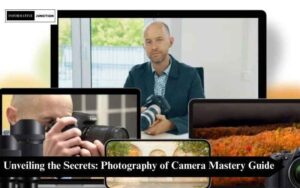In the dynamic realm of photography, the quest for the perfect shot begins with the right tool in hand—the best camera for photography. Whether you’re a seasoned professional or an enthusiastic beginner, the choice of your camera can significantly impact the outcome of your visual storytelling. Join us on a journey to explore the features, capabilities, and top picks that make a camera stand out in the competitive world of photography.
Understanding Photography Needs: Choosing the Right Camera
Embarking on Your Photographic Journey: Considerations for Camera Selection
Before delving into specific camera models, it’s crucial to understand your photography needs. Consider factors such as the type of photography you specialize in, your skill level, and your budget. This foundational step ensures that the camera you choose aligns seamlessly with your artistic vision.
Top Camera Features to Look for
Beyond Megapixels: Key Features That Define a Superior Camera
1. Image Sensor: The Heart of Visual Capture
Sensor Sensibility: Impact on Image Quality
The image sensor is a critical component of any camera. In low-light situations in particular, larger sensors tend to capture more light, leading to higher picture quality. Understand the types of sensors (Full-frame, APS-C, Micro Four Thirds) and choose based on your preferences and requirements.
2. Autofocus System: Precision in Every Frame
Sharp Focus: Evaluating Autofocus Capabilities
A robust autofocus system is essential for capturing sharp and well-defined images. Look for cameras with fast and accurate autofocus capabilities, especially if you’re into dynamic subjects like sports or wildlife photography.
3. ISO Range: Managing Light Sensitivity
Versatility in Light: Expanding ISO Capabilities
A camera’s ability to detect light is defined by its ISO range. A broader ISO range allows you to shoot in various lighting conditions. Cameras with excellent low-light performance are crucial for capturing stunning images without introducing excessive noise.
4. Lens Compatibility: Exploring Artistic Options
Lens Versatility: Interchangeable Lens Systems
Consider whether the camera supports interchangeable lenses. This feature provides flexibility and allows you to explore different lenses for diverse photographic styles, from wide-angle landscapes to telephoto wildlife shots.
Best Cameras for Different Photography Styles
Tailoring the Tool to Your Craft: Top Picks for Various Genres
1. Portrait Photography: Canon EOS 5D Mark IV
Capturing Portraits with Precision: Exceptional Detail and Color
For portrait photographers, the Canon EOS 5D Mark IV stands out with its high-resolution sensor, excellent autofocus, and impressive low-light performance. The camera delivers stunning skin tones and intricate details, making it a favorite among portrait enthusiasts.
2. Landscape Photography: Nikon D850
Scenic Splendor: High Resolution and Dynamic Range
Landscape photographers often seek cameras with high resolution and exceptional dynamic range. The Nikon D850 excels in these aspects, offering a 45.7-megapixel sensor and impressive color reproduction for breathtaking landscape shots.
3. Street Photography: Sony Alpha a7 III
Compact Powerhouse: Agility for Candid Moments
Street photographers value compactness, speed, and low-light capabilities. The Sony Alpha a7 III combines these features with excellent autofocus and image stabilization, making it an ideal companion for capturing candid moments in urban environments.
4. Wildlife Photography: Canon EOS-1D X Mark III
Chasing the Wild: Speed and Precision for Wildlife Shots
Wildlife photographers require cameras with fast burst rates, superior autofocus, and rugged durability. The Canon EOS-1D X Mark III excels in these areas, ensuring that you never miss a moment in the wild.
5. Sports Photography: Nikon D6
Freeze the Action: Fast Autofocus and Burst Speed
Sports photographers demand speed and precision. The Nikon D6 offers an advanced autofocus system, rapid burst rates, and excellent low-light performance, making it an ideal choice for capturing fast-paced sporting events.
Mirrorless vs. DSLR: Choosing the Right Camera Type
Technological Evolution: Navigating Between Mirrorless and DSLR
1. Mirrorless Cameras: Compact and Innovative
Compact Prowess: Embracing the Mirrorless Revolution
Mirrorless cameras, with their compact designs and electronic viewfinders, have gained popularity for their portability and advanced features. They are an excellent choice for photographers seeking a lightweight and versatile tool.
2. DSLR Cameras: Proven Performance and Optical Viewfinders
Optical Excellence: Staying True to DSLR Heritage
DSLRs, with their optical viewfinders and established performance, continue to be favored by many photographers. They offer a tangible and immersive shooting experience, making them the preferred choice for those who appreciate traditional camera design.
Camera Accessories: Enhancing Your Photographic Arsenal
Beyond the Body: Must-Have Accessories for Photographers
1. Quality Lenses: Expanding Your Creative Horizon
Glass Matters: Choosing Lenses Wisely
Investing in quality lenses is as important as choosing the right camera. New insights and avenues for creativity can be revealed through various lenses. Consider a range of lenses, from wide-angle for landscapes to prime lenses for portraits.
2. Tripods and Stabilizers: Ensuring Sharpness
Steady Shots: Importance of Tripods and Stabilizers
For long exposure shots, telephoto photography, or capturing video, a sturdy tripod or stabilizer is indispensable. It ensures that your shots remain sharp, especially in low-light conditions or when using heavy telephoto lenses.
3. Camera Bags: On-the-Go Gear Protection
Safe Travels: Choosing the Right Camera Bag
Investing in a reliable camera bag is crucial for protecting your gear while on the move. Look for a bag that accommodates your camera body, lenses, and other accessories while providing easy access and protection from the elements.
Camera Maintenance and Care: Prolonging the Lifespan of Your Gear
Preserving Precision: Tips for Keeping Your Camera in Prime Condition
1. Sensor Cleaning: A Delicate Operation
Dust Be Gone: Safely Cleaning Your Camera’s Sensor
Regular sensor cleaning is essential for maintaining image quality. Use proper tools and techniques to remove dust and debris, ensuring that your camera’s sensor remains free of blemishes that can affect your photos.
2. Lens Cleaning: Crystal Clear Optics
Crystal Clear Views: Caring for Your Lenses
Cleaning your lenses is crucial for achieving sharp and clear images. Use a lens-cleaning solution, a microfiber cloth, and gentle techniques to keep your lenses free from smudges and dust.
3. Firmware Updates: Keeping Technology Current
Digital Vigilance: Updating Your Camera’s Firmware
Manufacturers often release firmware updates to improve camera performance and address any bugs. Regularly check for and install these updates to ensure that your camera operates at its full potential.
Photography Tips and Techniques: Mastering Your Craft
Beyond the Basics: Elevate Your Photography Skills
1. Mastering Composition: The Rule of Thirds
Balancing Act: The Art of Composition
An essential principle of composition is the rule of thirds. Divide your frame into thirds both horizontally and vertically, placing key elements along these lines or at their intersections to create visually appealing and balanced shots.
2. Understanding Lighting: Natural and Artificial
Painting with Light: Harnessing the Power of Illumination
Whether shooting in natural or artificial light, understanding how light behaves is crucial. Experiment with different lighting conditions to create mood and atmosphere in your photographs.
3. Post-Processing Techniques: Enhancing Your Images
Digital Darkroom Magic: Refining Your Photographs
Post-processing allows you to enhance your images further. Experiment with software like Adobe Lightroom or Photoshop to adjust exposure, contrast, and colors to achieve your desired look.
Conclusion: Your Photographic Journey Begins
In conclusion, finding the best camera for photography involves a thoughtful consideration of your artistic vision, style, and technical requirements. The photography landscape offers a diverse array of cameras, each tailored to specific needs and preferences. Whether you opt for a mirrorless or DSLR, invest in quality lenses, or explore advanced accessories, your chosen camera becomes the conduit for your creative expression. As you embark on your photographic journey, remember that the best camera is the one that empowers you to capture moments with precision and passion. May your chosen camera be the tool that brings your unique vision to life, allowing you to paint with light and create visual stories that resonate with the world. Happy shooting!
Read More Informative Blogs on Informative Junction




